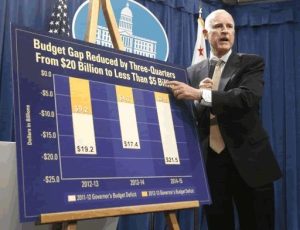Sacramento, CA — Governor Jerry Brown unveiled a revised $124-billion General Fund Budget for the upcoming fiscal year.
Total spending, when adding in special funds and bonds, will be around $183.4-billion. In January, the Governor was projecting a year-end deficit of around $5.8-billion, but the figure is now closer to $3.3-billion, due to improved capital gains.
At a press conference this morning, the Governor said the state should still take a cautious approach when it comes to spending. He noted, “Over the past four years, we have increased spending by billions of dollars for education, health care, child care and other anti-poverty programs. In the coming year, I don’t think even more spending will be possible. We have ongoing pressures from Washington and an economic recovery that won’t last forever.”
There is still some new spending, not included in the January budget, and it includes additional money for schools, child care programs, paying down pension debt and improving the transportation infrastructure.
Chad Mayes, Assembly Republican leader, is speaking out against the Governor’s budget plan. He has issued a statement, reading, “Unfortunately this proposal fails to move California in the right direction. Voters recently approved taxes specifically to fund increased access to health and dental care and to support our schools(Cigarette Tax Increase). But this budget pulls a bait and switch, sending that money to the General Fund while ignoring our health and dental care needs and eliminating programs like Career Technical Education in our schools.”
The Governor’s Office has released the below outline on the spending changes in the revised budget:
Keeping Child Care Funding On Track
The Governor’s January budget proposal called for a one-year delay in providing rate increases to child care providers that were reflected in the 2016 Budget Act. The May Revision proposes to restore this funding and maintain the $500 million child care package from the 2016 Budget.
Maintaining County Fiscal Health
Under current law, with the end of the Coordinated Care Initiative, county realignment funds would experience an increase in annual IHSS costs of about $600 million. The May Revision mitigates this increase in county costs by contributing $400 million from the General Fund and then smaller amounts in future years as realignment revenues grow.
Improving California’s Transportation System
This spring, the Legislature and Governor agreed on a historic transportation funding package – the Road Repair and Accountability Act of 2017 (SB 1). The funding package returns the gas tax’s purchasing power to 1994 levels and will provide $54 billion in new funding over the next decade, split evenly between state and local funding. The May Revision enhances oversight of Caltrans and allows the state and local governments to implement the SB 1 plan in a cost-effective manner without delay. The May Revision reflects the first $2.8 billion of new funding to:
· Focus on “fix-it-first” investments to repair neighborhood roads and state highways and bridges.
· Make key investments in trade and commute corridors to support continued economic growth and implement a sustainable freight strategy.
· Match locally generated funds for high-priority transportation projects.
· Invest in passenger rail and public transit modernization and improvement.
Reducing Pension Liabilities
The May Revision proposes a $6 billion supplemental payment to CalPERS with a loan from the Surplus Money Investment Fund – a step that will save the state $11 billion over the next two decades while continuing to reduce unfunded liabilities and stabilize state contribution rates. The General Fund share of the repayment will come from Proposition 2’s revenues dedicated to reducing debts and long-term liabilities.
Recognizing Budget Pressures and Threats
The state must also continue to plan and save for tougher budget times ahead. The federal government is contemplating actions – such as defunding health care for millions of Californians, eliminating the deductibility of state taxes and zeroing out funding for organizations like Planned Parenthood – that could send the state budget into turmoil. Moreover, by the time the budget is enacted in June, the economy will have finished its eighth year of expansion – just two years short of the longest recovery since World War II.


